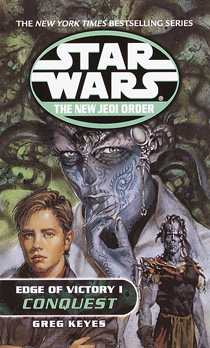The stories of Jaina, Jacen, Lowbacca and other “next generation” characters’ youthful days were explored in the “Young Jedi Knights” series, written for young adults. But that series doesn’t account for all the next-gen characters. Notably, Anakin and Tahiri had their younger days chronicled in the six-book “Junior Jedi Knights” series (1995-97), written for junior readers by Nancy Richardson and Rebecca Moesta.
First-time “Star Wars” author Greg Keyes has the task of integrating Anakin’s and Tahiri’s backstories into the adult novels in “Edge of Victory I: Conquest” (2001), the seventh book in the “New Jedi Order” saga. It’s the first book where Anakin is a main character and also the first to feature Tahiri, although she briefly appears in “Agents of Chaos II: Jedi Eclipse.”
Although I hadn’t read “Junior Jedi Knights” due to the books being aimed at a younger audience (which hasn’t stopped some die-hard adult fans from delving into them), Keyes smoothly integrates the close friendship of Anakin and Tahiri, who are ages 16 and 14, respectively, in “Conquest.” Although it’s somewhat odd that Anakin doesn’t think of his friendship with Tahiri in his previous “NJO” adventures, it makes sense given that he’s a self-absorbed teen who is somewhat worried about the notion of strong feelings leading to the dark side. Keyes smartly latches on to the concept that Tahiri has hurt feelings about Anakin adventuring around the galaxy and not dropping her a line.
“Conquest” is an excellent “Star Wars” debut by Keyes, who I tend to underrate because he only penned three books, all in the “NJO.” He immediately makes Tahiri into a central “Star Wars” EU character. She and Anakin love each other (although Anakin only explicitly says so when trying to bring her back from the brink of her Yuuzhan Vong brainwashing). The novel is almost entirely set on Yavin 4, with Anakin trekking through the jungle to rescue Tahiri from Vong shapers. Meanwhile, Tahiri undergoes the preliminary stages of shaping, so even after she is rescued, she still has to deal with the feeling of being part “Riina Qwaad” and part Tahiri Veila. Anakin sees that Tahiri’s green eyes, once filled with laughter, have now gone ice-cold. A reader feels pain for him and Tahiri, and roots for her to find her way back to humanity.
This is the first-published story where a Yuuzhan Vong helps one of our heroes, although if you’re reading the EU chronologically, you already met a heroic Vong character in “Invasion.” In “Conquest,” Vua Rapuung aims for revenge on the Shaper Mezhan Qwaad, who made him appear to be a Shamed One. He’s teams up with Anakin only because their goals align. The exchanges between the two characters help both Anakin and the reader grasp the Vong worldview for the first time.
Most notably, Anakin notes that since the Vong don’t appear in the Force, and since Jedi serve the Force, perhaps he is wrong to fight the Vong at all. The galaxy is home to our heroes, but on the other hand, the Vong’s gods have gifted them with the galaxy. Certainly, a reader is not being asked to accept excuses for a species that aims to conquer rather than to live peacefully, but it’s still interesting food for thought. And Anakin – in contrast to Jacen, who looks for reasons to avoid fights – believes his knowledge of his enemy will help him to fight them better.

Also coming over from “Junior Jedi Knights” is Ikrit, a wise old Jedi, and young Sannah, a student from Yavin 8. (In addition to Yavin 4, Yavin 8 and Yavin 13 are also habitable. Yavin 8 is featured in “Junior Jedi Knights,” but no stories take place on Yavin 13.) Corran’s son, Valin Horn, is also revealed to be a Jedi Academy student here, although he doesn’t appear in the “Junior” books. Keyes peppers in a nod to “Young Jedi Knights,” too, with the return of Qorl, a TIE-fighter-pilot-turned-hermit who had menaced and eventually befriended Jacen and Jaina.
Another interesting continuity note finds the Great Temple smashed flat (and its materials repurposed for Shaper damuteks) by the Yuuzhan Vong after having stood for 5,000 years. The Temple SEEMED to have been destroyed once before – by, as Luke says, “concussion charges planted (by General Dodonna) all over the main buildings” in Issue 16 of “Classic Star Wars.” However, the Great Temple is still standing in all future stories, so I guess we’re supposed to assume the bombs didn’t destroy the Great Temple itself, but merely other “main buildings.” (Indeed, we also later learn that Dodonna survived the blasts and was captured by the Empire.)
All the references to past stories are great, but ultimately Keyes moves the “NJO” saga forward by delving into Anakin and Tahiri and the culture of the Yuuzhan Vong Shamed Ones and Shapers. Book nine, “Star by Star,” kills off Anakin, which was a switch from the original plan to kill off Jacen. I’m not sure if the change was made at the time Keyes wrote his duology, or if it came when Troy Denning was writing “Star by Star.”
I suspect Keyes knew Anakin’s “Star by Star” fate, as “The Essential Reader’s Companion” notes that his duology was a replacement for a canceled trilogy that would have focused on the Peace Brigade and Danni Quee (a potential love interest for Jacen, and someone who – like Tahiri – had experience as a Vong captive). Either way, it’s important that we get to know the youngest Solo child so his demise packs a punch.

